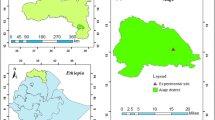Abstract
In areas with restriction of water resource access for agricultural activities, one of the most challenging issues is determining irrigation depth in such a way that gets high efficiency. A field experiment was conducted to evaluate three different irrigation scenarios; in which irrigation depth was determined by WASH_1D/2D model and FAO method; as well as rainfed (no irrigation) treatment, in the fine textured soil under potato cultivation. The results showed that simulating method could optimize water use with considering weather forecast data as 6 irrigation events and 12.6 mm depth, compared to 10 irrigation events and 37.3 mm depth for FAO method. A significant difference was observed among gained yield under irrigated and rainfed plots that implied irrigation importance even in rainy season. The applied water efficiency values for simulated and FAO methods was gained as 198 and 70 g/mm, respectively; which indicate the WASH_1D/2D model may be an appropriate choice to determine irrigation depth considering water use optimizing in regions with water supply problems.





Similar content being viewed by others
REFERENCES
A. Alizadeh and A. Keshavarz, Water Conservation, Reuse, and Recycling: Proceedings of an Iranian-American Workshop (National Academies of Sciences, Engineering, and Medicine, The National Academies Press, Washington, DC, 2005).
R. Allen, L. A. Pereira, D. Raes, and M. Smith, Crop Evapotranspiration Guidelines for Computing Crop Water Requirements, Irrigation and Drainage Paper No. 56 (FAO, Rome, 1998).
A. Anshori, T. E. Suswatiningsih, and N. A. Viandari, “Effect of supplementary irrigation on rice yield in dry land during rainy season,” IOP Conf. Ser. Earth Environ. Sci. 824 (1), 012091 (2019). https://doi.org/10.1088/1755-1315/824/1/012091
D. L. Corwin and S. R.Grattan, “Are existing irrigation salinity leaching requirement guidelines overly conservative or obsolete?,” J. Irrig. Drain. Eng. 144, 02518001 (2018). https://doi.org/10.1061/(ASCE)IR.1943-4774.0001319
H. M. A. El Baki, H. Fujimaki, I. Tokumoto, and T. Saito, “Determination of irrigation depths using a numerical model of crop growth and quantitative weather forecast and evaluation of its effect through a field experiment for potato,” J. Jpn. Soc. Soil Phys. 136, 15–24 (2017). https://doi.org/10.34467/jssoilphysics.136.0_15
H. M. A. El Baki, H. Fujimaki, I. Tokumoto, and T. Saito, “A new scheme to optimize irrigation depth using a numerical model of crop response to irrigation and quantitative weather forecasts,” Comput. Electron. Agric. 150, 387–393 (2018). https://doi.org/10.1016/j.compag.2018.05.016
H. M. A. El Baki, M. Raoof, and H Fujimaki, “Determining irrigation depths for soybean using a simulation model of water flow and plant growth and weather forecasts,” Agronomy 10, 369 (2020). https://doi.org/10.3390/agronomy10030369
H. Fujimaki, H. M. Abd El Baki, S. Mohamad Mahdavi, and H. Ebrahimian, “Optimization of irrigation and leaching depths considering the cost of water using WASH_1D/2D models,” Water 12 (9), 2549 (2020). https://doi.org/10.3390/w12092549
H. Fujimaki, I. Tokumoto, T. Saito, M. Inoue, M. Shibata, T. Okazaki, K. Nagaz, and F. El Mokh, “Determination of irrigation depths using a numerical model and quantitative weather forecast and comparison with an experiment,” in Practical Applications of Agricultural System Models to Optimize the Use of Limited Water, Ed. by L. R. Ahuja, L. Ma, and R. J. Lascano (ACSESS, Madison, 2014), Vol. 5, pp. 209–235. https://doi.org/10.2134/advagricsystmodel5.c9
C. García-Gutiérrez, Y. Pachepsky, and M. A. Martín, “Saturated hydraulic conductivity and textural heterogeneity of soils,” Hydrol. Earth Syst. Sci. 22 (7), 3923–3932 (2018). https://doi.org/10.5194/hess-22-3923-2018
R. González Perea, J. A. Andre Daccache, E. Rodríguez Díaz, C. Poyato, and W. K. Jerry, “Modelling impacts of precision irrigation on crop yield and in-field water management,” Precis. Agric. 19, 497–512 (2018). https://doi.org/10.1007/s11119-017-9535-4
H. T. Hwang, S. W. Jeen, A. A. Suleiman, and K. K. Lee, “Comparison of saturated hydraulic conductivity estimated by three different methods,” Water 9, 942 (2017). https://doi.org/10.3390/w9120942
IUSS Working Group WRB, World Reference Base for Soil Resources 2014, Update 2015, International Soil Classification System for Naming Soils and Creating Legends for Soil Maps, World Soil Resources Reports, No. 106 (UN Food and Agriculture Organization, Rome, 2015).
M. Khorsandi, S. Homayouni, and P. van Oel, “The edge of the petri dish for a nation: water resources carrying capacity assessment for Iran,” Sci. Total Environ. 817, 153038 (2022). https://doi.org/10.1016/j.scitotenv.2022.153038
A. Kumari, A. Upadhyaya, P. Jeet, N. Al-Ansari, J. Rajput, P. K. Sundaram, K. Saurabh, V. Prakash, A. K. Singh, and R. K. Raman, “Estimation of actual evapotranspiration and crop coefficient of transplanted puddled rice using a modified non-weighing paddy lysimeter,” Agronomy 12 (11), 2850 (2022). https://doi.org/10.3390/agronomy12112850
J. Letey and G. Feng, “Dynamic versus steady-state approaches to evaluate irrigation management of saline waters,” Agric. Water Manage. 91, 1–10 (2007). https://doi.org/10.1016/j.agwat.2007.02.014
S. M. Mahdavi and H. Fujimaki, “Soil salinity resistance effect on evaporation,” Eurasian Soil Sci. 52, 526–534 (2019). https://doi.org/10.1134/S1064229319050089
M. W. Nasir and Z. Toth, “Effect of drought stress on potato production: a review,” Agronomy 12 (3), 635 (2023). https://doi.org/10.3390/agronomy12030635
T. W. Negash, G. Dirirsa Bayisa, and A. T. Tefera, “Evapotranspiration and crop coefficient of sorghum (Sorghum bicolor L.) at Melkassa farmland, semi-arid area of Ethiopia,” Air, Soil Water Res. 16, (2023). https://doi.org/10.1177/11786221231184206"10.1177/11786221231184206
K. Seki, N. Toride, and M. Th. van Genuchten, “Closed-form hydraulic conductivity equations for multimodal unsaturated soil hydraulic properties,” Vadose Zone J. 21 (1), e20168 (2022). https://doi.org/10.1002/vzj2.20168
T. Talsma, “Prediction of hydraulic conductivity from soil water retention data,” Soil Sci. 140, 184–188 (1985).
J. P. Walker, G. R. Willgoose, and J. D. Kalma, “In situ measurement of soil moisture: a comparison of techniques,” J. Hydrol. 293 (1–4), 85–89 (2004). https://doi.org/10.1016/j.jhydrol.2004.01.008
Funding
This work was supported by ongoing institutional funding. No additional grants to carry out or direct.
Author information
Authors and Affiliations
Corresponding author
Ethics declarations
ETHICS APPROVAL AND CONSENT TO PARTICIPATE
This work does not contain any studies involving human and animal subjects.
CONFLICT OF INTEREST
The authors of this work declare that they have no conflicts of interest.
Additional information
Publisher’s Note.
Pleiades Publishing remains neutral with regard to jurisdictional claims in published maps and institutional affiliations.
Rights and permissions
About this article
Cite this article
Mahdavi, S.M., Fujimaki, H. Optimization of Irrigation Depth Considering Weather Forecast and Water Use Efficiency in Potato Cultivation. Eurasian Soil Sc. (2024). https://doi.org/10.1134/S1064229324700297
Received:
Revised:
Accepted:
Published:
DOI: https://doi.org/10.1134/S1064229324700297




